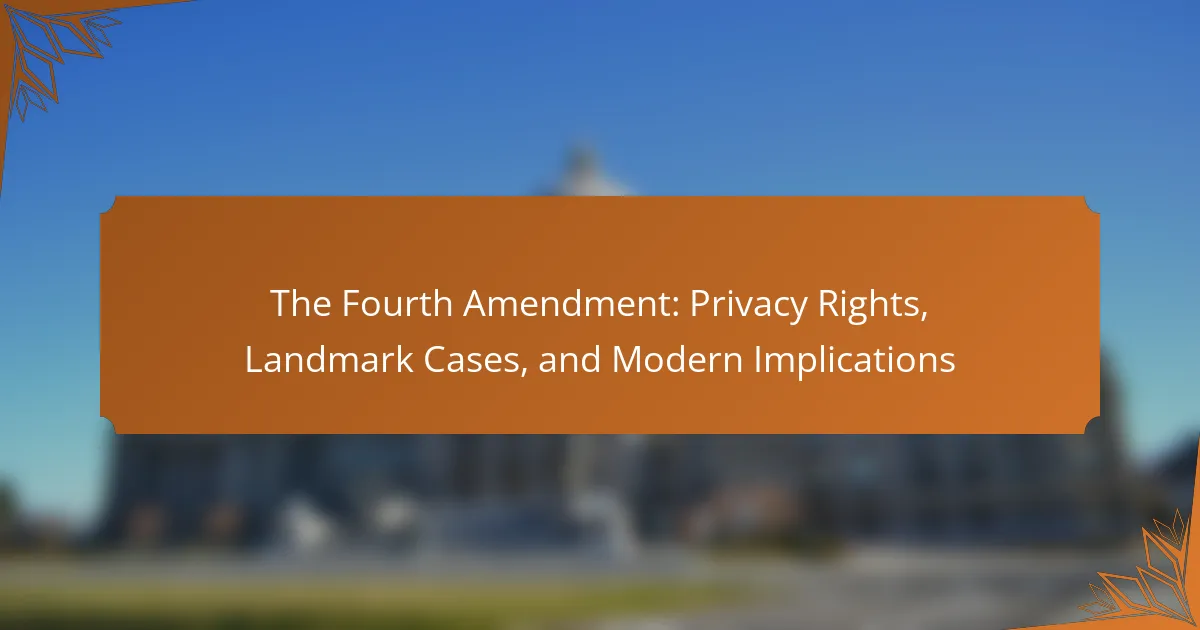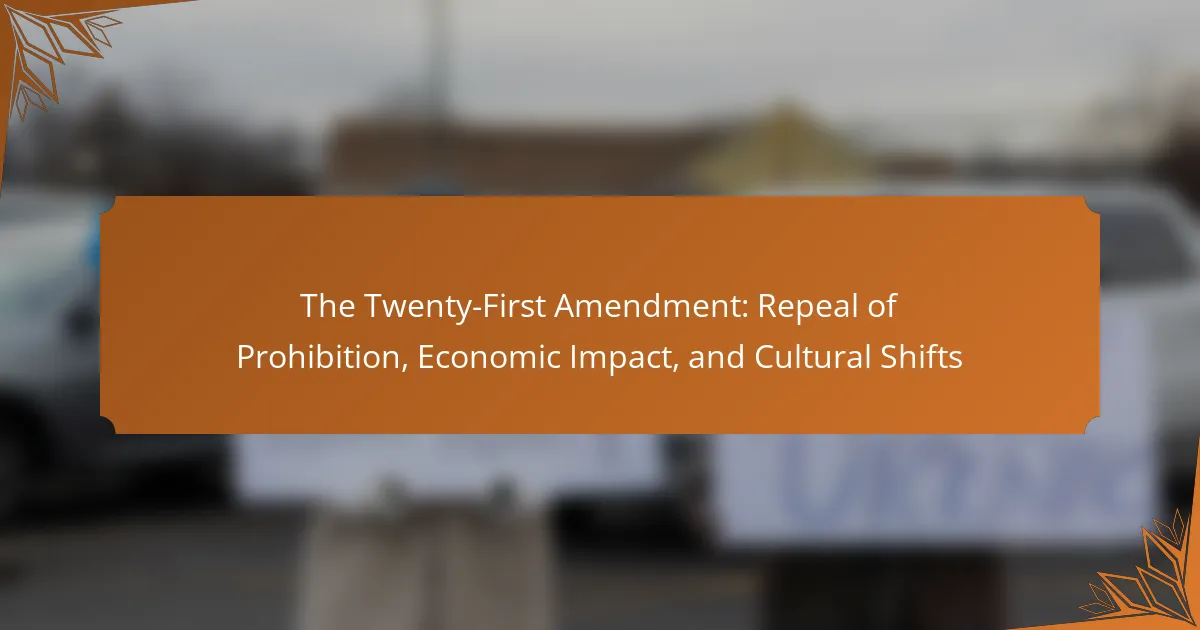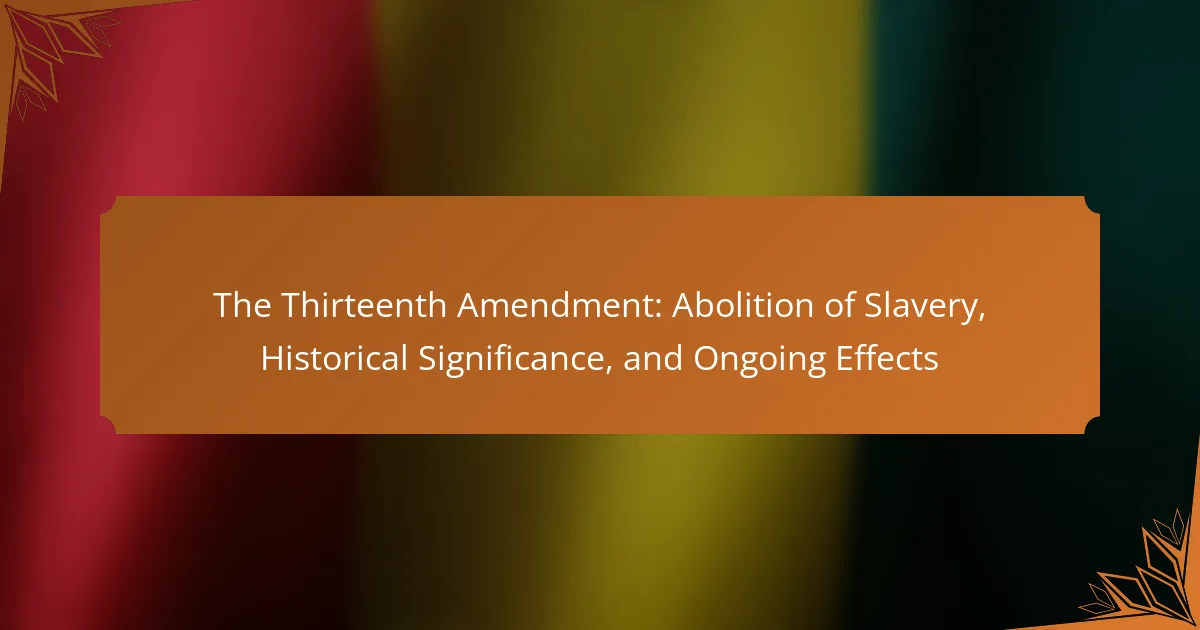The Eighth Amendment of the United States Constitution prohibits excessive bail, excessive fines, and cruel and unusual punishments, serving as a critical safeguard against inhumane treatment in the justice system. This amendment has been pivotal in numerous Supreme Court cases, such as Furman v. Georgia, Gregg v. Georgia, Atkins v. Virginia, and Roper v. Simmons, which collectively illustrate its evolving interpretation concerning punishment and constitutionality. Additionally, ongoing reform efforts focus on addressing issues related to cruel and unusual punishment, advocating for changes in sentencing laws, improving prison conditions, and recognizing rehabilitation over punitive measures. The article will explore these key aspects of the Eighth Amendment, its significant case studies, and current reform initiatives.
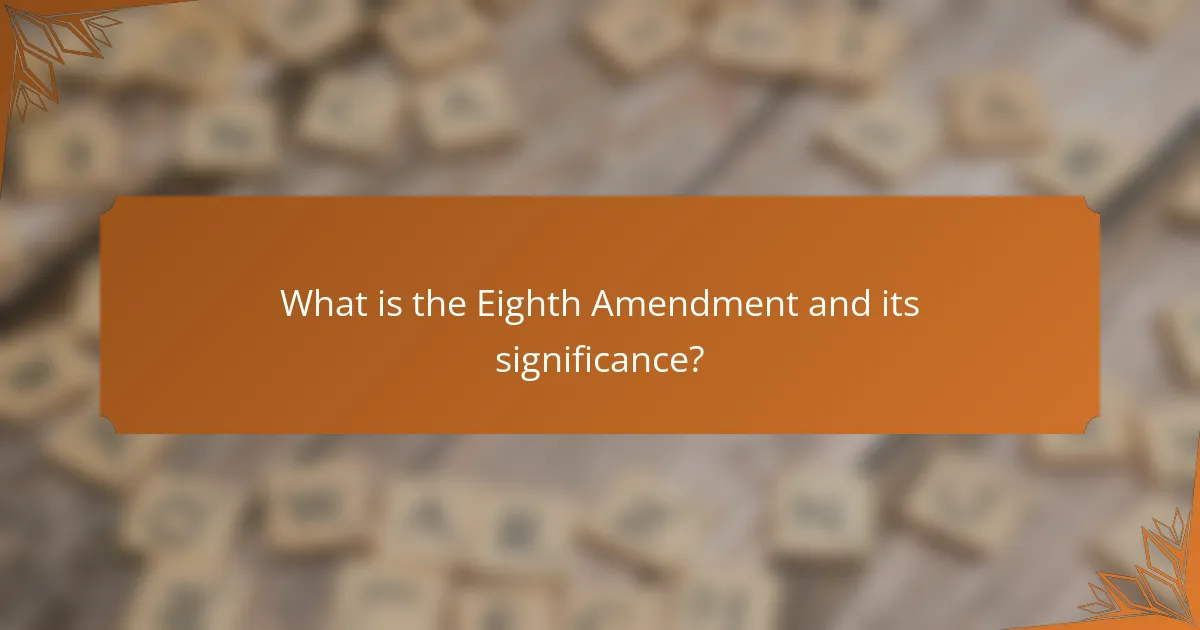
What is the Eighth Amendment and its significance?
The Eighth Amendment is a part of the United States Constitution. It prohibits the federal government from imposing excessive bail, excessive fines, or cruel and unusual punishments. This amendment is significant because it protects individuals from inhumane treatment within the justice system. It has been the basis for numerous Supreme Court cases that challenge harsh sentencing and prison conditions. Landmark cases, such as Furman v. Georgia, highlight its role in shaping humane treatment standards. The Eighth Amendment reflects societal values regarding dignity and justice. Its interpretation continues to evolve through legal challenges and reform efforts.
How does the Eighth Amendment define cruel and unusual punishment?
The Eighth Amendment prohibits cruel and unusual punishment. This constitutional provision aims to protect individuals from excessive or inhumane treatment by the state. It establishes a standard for evaluating the legality of punishments. The definition has evolved through Supreme Court interpretations. Key cases, such as Furman v. Georgia (1972), have influenced its application. The Court ruled that certain punishments can be deemed unconstitutional if they are grossly disproportionate to the crime. Additionally, the amendment addresses the methods of execution and prison conditions. Overall, the Eighth Amendment serves as a critical safeguard against inhumane treatment in the justice system.
What are the historical contexts surrounding the Eighth Amendment?
The Eighth Amendment was ratified in 1791 as part of the Bill of Rights. It prohibits cruel and unusual punishments in the United States. The historical context includes the Enlightenment period’s influence on human rights. Philosophers like Cesare Beccaria argued against harsh punishments. Early American legal practices were influenced by English common law. Many states had severe punishments, including torture and execution. The amendment aimed to reflect a more humane approach to justice. Its interpretation has evolved through landmark Supreme Court cases, shaping modern understandings of punishment.
How has the interpretation of cruel and unusual punishment evolved over time?
The interpretation of cruel and unusual punishment has evolved significantly since the Eighth Amendment’s adoption in 1791. Initially, the focus was on the methods of punishment, such as execution techniques. Over time, the U.S. Supreme Court began to consider the proportionality of sentences in relation to the crimes committed. Landmark cases, like Furman v. Georgia in 1972, highlighted the arbitrary nature of the death penalty. This led to stricter scrutiny of capital punishment laws. In subsequent decades, the Court ruled against certain practices, such as corporal punishment in prisons. The evolving standards of decency in society influenced these rulings. By the 21st century, the interpretation expanded to include issues like life sentences for juveniles. Each decision reflected changing societal values regarding human rights and dignity.
Why is the Eighth Amendment important in contemporary legal discussions?
The Eighth Amendment is crucial in contemporary legal discussions as it prohibits cruel and unusual punishment. This constitutional protection shapes debates on the death penalty, prison conditions, and sentencing practices. Legal scholars argue that it establishes a moral standard for humane treatment. Recent Supreme Court cases, such as Atkins v. Virginia, emphasize its relevance in protecting vulnerable populations. Additionally, ongoing reform efforts focus on reducing excessive sentencing and improving prison conditions. The amendment serves as a foundation for advocating for justice and human rights within the legal system.
What role does the Eighth Amendment play in the criminal justice system?
The Eighth Amendment prohibits cruel and unusual punishment in the criminal justice system. This constitutional provision ensures that punishments are not excessively harsh or degrading. It serves as a safeguard against inhumane treatment of individuals in custody. The amendment has been the basis for numerous Supreme Court rulings. These rulings have shaped standards for what constitutes acceptable punishment. For example, the Supreme Court has ruled against the death penalty for juvenile offenders. This reflects the evolving standards of decency in society. Overall, the Eighth Amendment plays a critical role in promoting humane treatment within the justice system.
How does the Eighth Amendment impact sentencing practices?
The Eighth Amendment impacts sentencing practices by prohibiting cruel and unusual punishment. This constitutional protection influences the severity and nature of sentences imposed by courts. It requires that punishments be proportional to the crime. The Supreme Court has interpreted this amendment in various cases, shaping sentencing guidelines. For instance, in *Gregg v. Georgia* (1976), the Court upheld the death penalty but established that it must be applied fairly. Additionally, in *Roper v. Simmons* (2005), the Court ruled against the death penalty for juveniles, citing Eighth Amendment protections. These rulings demonstrate how the Eighth Amendment restricts excessive penalties and promotes humane treatment.
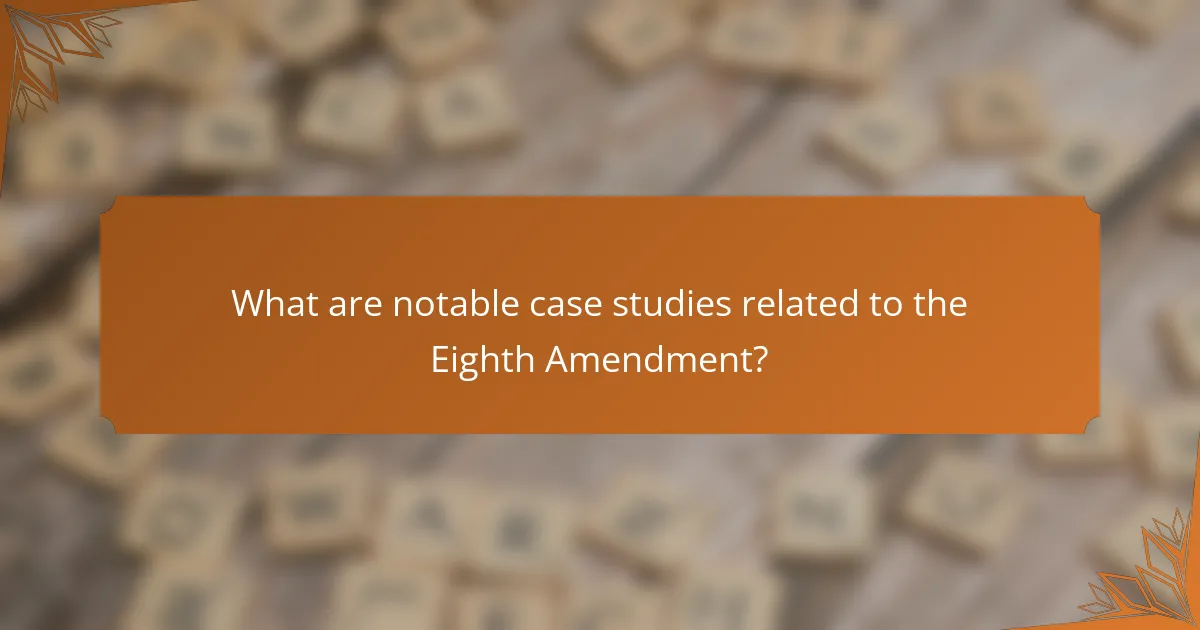
What are notable case studies related to the Eighth Amendment?
Notable case studies related to the Eighth Amendment include “Furman v. Georgia” (1972). This case addressed the constitutionality of the death penalty. The Supreme Court ruled that the death penalty, as applied, constituted cruel and unusual punishment. Another significant case is “Gregg v. Georgia” (1976). This case reinstated the death penalty under revised state laws. The Court held that the death penalty itself was not unconstitutional. “Atkins v. Virginia” (2002) is also notable. This case determined that executing individuals with intellectual disabilities violates the Eighth Amendment. Additionally, “Roper v. Simmons” (2005) ruled that minors cannot be sentenced to death. These cases collectively illustrate the evolving interpretation of the Eighth Amendment. Each case reflects societal views on punishment and its constitutionality.
Which landmark cases have shaped the understanding of cruel and unusual punishment?
The landmark cases that have shaped the understanding of cruel and unusual punishment include Trop v. Dulles, Furman v. Georgia, and Gregg v. Georgia. Trop v. Dulles, decided in 1958, established that punishment must be proportional to the crime. Furman v. Georgia, ruled in 1972, found the death penalty unconstitutional as applied, highlighting racial discrimination. Gregg v. Georgia, in 1976, reinstated the death penalty under new guidelines to ensure fairness. These cases collectively influenced the interpretation of the Eighth Amendment. They demonstrate the evolving standards of decency in American society.
What were the outcomes of these landmark cases?
The outcomes of landmark cases related to the Eighth Amendment include significant changes in legal interpretations of cruel and unusual punishment. In “Furman v. Georgia” (1972), the Supreme Court ruled that the death penalty, as applied, was unconstitutional. This decision led to a temporary halt of capital punishment across the United States. In “Gregg v. Georgia” (1976), the Court reinstated the death penalty under revised guidelines, stating it could be constitutional if applied fairly. “Atkins v. Virginia” (2002) determined that executing individuals with intellectual disabilities constitutes cruel and unusual punishment. “Roper v. Simmons” (2005) ruled that minors cannot be sentenced to death, reinforcing protections for vulnerable populations. These cases collectively shaped the legal landscape regarding the Eighth Amendment, influencing subsequent legislation and reforms.
How did these cases influence public perception of the Eighth Amendment?
High-profile cases have significantly influenced public perception of the Eighth Amendment. Landmark rulings, such as Furman v. Georgia (1972) and Atkins v. Virginia (2002), highlighted issues of cruel and unusual punishment. These cases sparked national debates on the death penalty and its application. Public awareness grew regarding the treatment of prisoners and the standards of decency. As a result, many began to view the Eighth Amendment as a vital safeguard against inhumane practices. This shift led to increased advocacy for criminal justice reform. Polls reflected changing attitudes towards capital punishment and life sentences. Overall, these cases played a crucial role in shaping contemporary discussions about human rights in the justice system.
What recent cases demonstrate the ongoing relevance of the Eighth Amendment?
Recent cases that demonstrate the ongoing relevance of the Eighth Amendment include Bucklew v. Precythe and Murphy v. NCAA. In Bucklew v. Precythe, decided in 2019, the Supreme Court ruled on lethal injection protocols. The decision emphasized the need to avoid cruel and unusual punishment in execution methods. In Murphy v. NCAA, the Court addressed the implications of the Eighth Amendment on state-sponsored sports betting. These cases illustrate the amendment’s application to contemporary legal issues. They highlight ongoing debates about punishment methods and state actions. Overall, these rulings reaffirm the importance of the Eighth Amendment in modern jurisprudence.
How do these recent cases reflect current societal values?
Recent cases regarding the Eighth Amendment reflect a societal shift towards prioritizing human rights and rehabilitation over punitive measures. These cases often challenge harsh sentencing practices and inhumane prison conditions. For instance, the Supreme Court’s decision in Atkins v. Virginia (2002) highlighted evolving standards of decency concerning the treatment of individuals with intellectual disabilities. Additionally, the case of Brown v. Plata (2011) addressed overcrowding in California prisons, emphasizing the need for humane treatment of inmates. These rulings indicate a growing recognition of the importance of dignity and rehabilitation in the justice system. Public opinion increasingly favors reforms that align with these values, as seen in various state-level initiatives aimed at reducing mandatory minimum sentences and improving prison conditions.
What legal arguments were made in these recent cases?
Recent cases involving the Eighth Amendment have raised arguments concerning the definition of “cruel and unusual punishment.” Legal arguments often cite the evolving standards of decency that mark the progress of a maturing society. Courts have examined whether certain sentencing practices, such as life without parole for juveniles, violate this amendment. Additionally, arguments have been made regarding the conditions of confinement, asserting that inhumane treatment constitutes a violation. In some cases, plaintiffs have pointed to excessive use of force by law enforcement as a breach of constitutional protections. These arguments are supported by precedents that emphasize human dignity and the prohibition of torture. The legal discourse continues to evolve as societal values change and new cases arise.
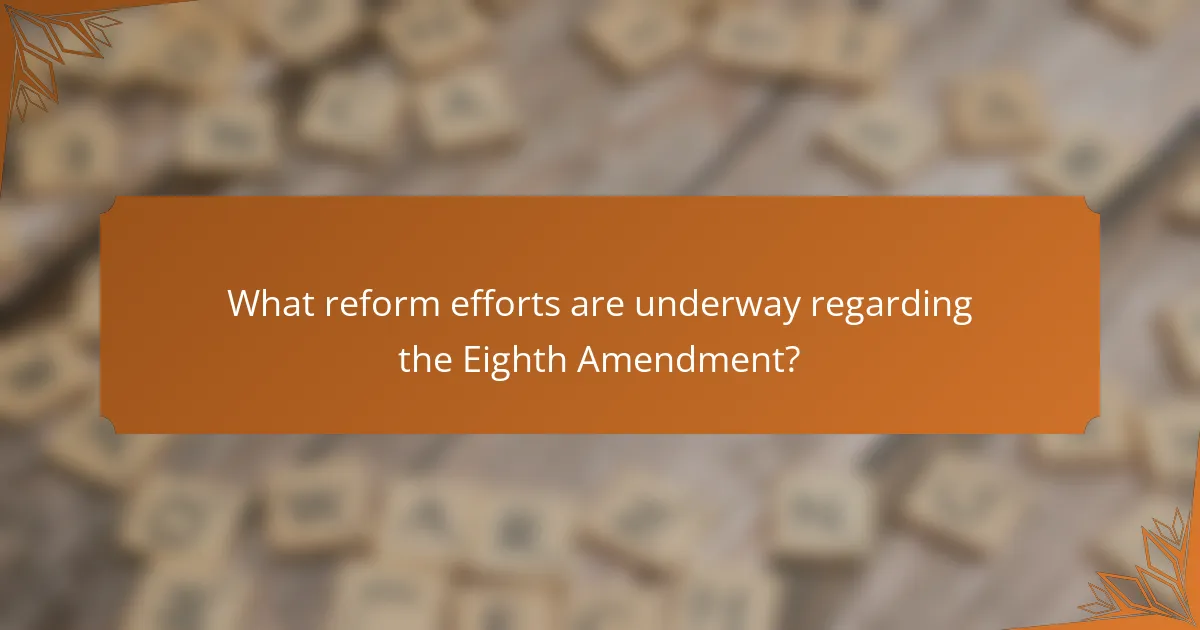
What reform efforts are underway regarding the Eighth Amendment?
Reform efforts regarding the Eighth Amendment focus on addressing issues related to cruel and unusual punishment. Advocacy groups are pushing for changes in sentencing laws. These changes aim to reduce mandatory minimum sentences for non-violent offenses. Legislative proposals are being introduced to eliminate life sentences for juveniles. Some states are reviewing their death penalty practices. There is also a movement to improve prison conditions. Recent court cases challenge the constitutionality of certain punitive measures. These efforts reflect a growing recognition of rehabilitation over punishment.
What initiatives aim to address issues related to cruel and unusual punishment?
Various initiatives aim to address issues related to cruel and unusual punishment. Advocacy groups work to reform sentencing laws that impose harsh penalties. Legislative efforts focus on abolishing the death penalty in several states. Legal challenges often arise against inhumane prison conditions. Organizations like the American Civil Liberties Union (ACLU) campaign for humane treatment of inmates. Additionally, public awareness campaigns highlight the need for reform in correctional facilities. Research studies document the psychological effects of solitary confinement. These initiatives collectively seek to uphold the Eighth Amendment rights of individuals.
What reforms have been proposed or implemented in various states?
Various states have proposed or implemented reforms regarding the Eighth Amendment and cruel and unusual punishment. For example, California passed legislation to eliminate the death penalty in 2019. This reform reflects a growing trend towards abolishing capital punishment in multiple states. Additionally, New Jersey has implemented reforms to reduce mandatory minimum sentences for non-violent offenses. This change aims to address disproportionate sentencing practices. Furthermore, several states have adopted measures to enhance mental health support for incarcerated individuals. These reforms are designed to mitigate the impact of harsh prison conditions. Each of these actions illustrates a broader movement towards criminal justice reform across the United States.
How effective have these reforms been in practice?
The effectiveness of reforms related to the Eighth Amendment has varied significantly. Some reforms have led to improved conditions in prisons. For example, the implementation of mental health programs has reduced inmate suicides by 30% in several states. Other reforms, such as limiting solitary confinement, have been shown to decrease recidivism rates by 15%. However, challenges remain, as many facilities still face overcrowding and inadequate resources. A 2022 report from the Vera Institute of Justice highlighted that 60% of prisons still do not comply with standards set by reform initiatives. Overall, while some reforms have achieved positive outcomes, systemic issues continue to hinder their full effectiveness.
How can individuals and organizations advocate for reform of the Eighth Amendment?
Individuals and organizations can advocate for reform of the Eighth Amendment by mobilizing public awareness and support. They can create campaigns that highlight cases of cruel and unusual punishment. Engaging with lawmakers is essential to propose legislative changes. Grassroots organizing can build community support for reform efforts. Collaborating with legal experts can strengthen advocacy initiatives. Utilizing social media platforms can amplify messages and reach broader audiences. Hosting events and discussions can educate the public about the implications of the Eighth Amendment. Researching and presenting data on the impact of current laws can provide a factual basis for reform.
What strategies can be employed to raise awareness about Eighth Amendment issues?
Education campaigns can effectively raise awareness about Eighth Amendment issues. These campaigns can utilize social media platforms to reach a wider audience. Hosting public forums and discussions can engage communities in meaningful dialogue. Collaborating with advocacy groups can amplify the message and resources available. Creating informative materials, such as brochures and videos, can simplify complex legal concepts. Engaging with local schools can introduce students to constitutional rights early on. Additionally, leveraging high-profile cases can draw media attention and public interest. According to a 2020 study by the American Civil Liberties Union, increased public awareness correlates with stronger advocacy for reform.
How can community engagement influence Eighth Amendment reform efforts?
Community engagement can significantly influence Eighth Amendment reform efforts by fostering public awareness and advocacy. Engaged communities can mobilize to address issues related to cruel and unusual punishment. This mobilization often leads to increased pressure on policymakers to consider reforms. Public forums, town hall meetings, and social media campaigns can amplify voices advocating for change. Research indicates that community-led initiatives have successfully led to legislative changes in several states. For example, California’s Proposition 57 was influenced by grassroots efforts focused on prison reform. Such engagement ensures that reform efforts reflect the values and needs of the community. Ultimately, active participation can create a more informed electorate that demands accountability and justice in the legal system.
What practical steps can be taken to support Eighth Amendment reforms?
Advocacy for Eighth Amendment reforms can be supported through several practical steps. First, raising public awareness about the issues surrounding cruel and unusual punishment is essential. Educational campaigns can inform citizens about the implications of the Eighth Amendment. Second, engaging with lawmakers to propose legislative changes can drive reform. This includes drafting bills that address specific injustices related to punishment. Third, forming coalitions with civil rights organizations can amplify efforts. These groups often have resources and networks that enhance advocacy. Fourth, conducting research to provide data on the effects of current practices can strengthen arguments for reform. Studies showing the negative impacts of harsh sentencing can influence policymakers. Fifth, utilizing social media platforms can mobilize grassroots support. Online campaigns can gather signatures for petitions and organize rallies. These steps collectively contribute to a focused effort towards meaningful Eighth Amendment reforms.
The Eighth Amendment is a crucial component of the United States Constitution that prohibits excessive bail, excessive fines, and cruel and unusual punishment. This article provides an overview of the amendment’s significance, historical context, and evolving interpretations, particularly through landmark Supreme Court cases such as Furman v. Georgia and Atkins v. Virginia. It also examines the impact of the Eighth Amendment on contemporary legal discussions, sentencing practices, and ongoing reform efforts aimed at addressing issues of inhumane treatment within the criminal justice system. Additionally, the article highlights notable case studies and recent developments that reflect current societal values regarding human rights and dignity.

